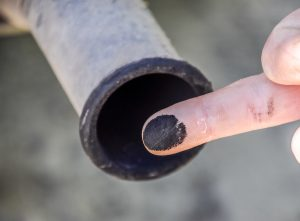Strong policies on black carbon can sharply cut glacier melt, says World Bank study
About Black Carbon

- Black carbon, or soot, is part of fine particulate air pollution (PM2.5) and contributes to climate change.
- Black carbon is formed by the incomplete combustion of fossil fuels, wood and other fuels. Complete combustion would turn all carbon in the fuel into carbon dioxide (CO2), but combustion is never complete and CO2, carbon monoxide, volatile organic compounds, and organic carbon and black carbon particles are all formed in the process.
- The complex mixture of particulate matter resulting from incomplete combustion is often referred to as soot.
- Black carbon is a short-lived climate pollutant with a lifetime of only days to weeks after release in the atmosphere. During this short period of time, black carbon can have significant direct and indirect impacts on the climate, the cryosphere (snow and ice), agriculture and human health.
What sectors are contributing Black carbon?
- Industry [primarily brick kilns] and residential burning of solid fuel together account for 45–66% of regional anthropogenic [man-made] BC deposition, followed by on-road diesel fuels (7–18%) and open burning (less than 3% in all seasons)
Black Carbon and Glaciers

- Glaciers are known to reflect sunlight back into the atmosphere, this is known as the Albedo effect. This reduces the absorption of sunlight and maintains temperature.
- The black carbon, which is mostly due to human activities, reaches high altitudes with the help of wind systems.
- Black carbon absorbs more light and emits infra-red radiation that increases the temperature. So, when there is an increase in black carbon in the high Himalayas, it will contribute to faster melting of Himalayan glaciers.
How black carbon is affecting the glacier melt?
- Deposits of BC act in two ways hastening the pace of glacier melt:
- By decreasing surface reflectance of sunlight (albedo effect) by glaciers
- By raising the air temperature.
About Himalaya, Karakoram and Hindu Kush (HKHK) mountain ranges

- The HKHK mountain ranges span 2,400 kilometers across six nations (Afghanistan, Bhutan, China, India, Nepal, and Pakistan).
- There are almost 55,000 glaciers in the HKHK mountains, and they store more freshwater “than any other region outside the North and South Poles”.
- The glaciers contain estimated ice reserves of 163 cubic kilometres, of which almost 80% feeds the Indus, the Ganges and the Brahmaputra, the report says. Snow and glacier melt from the HKHK play an important role in the timing and magnitude of water availability within the region.
- Glacier melt produces flash floods, landslips, soil erosion, and glacial lake outburst floods (GLOF), and in the short run, the higher volumes of melt water could replace receding groundwater downstream. But in the long run, decreased water availability would aggravate water shortage.
- The rate of retreat of HKHK glaciers is estimated to be 0.3 metres per year in the west to 1.0 metre per year in the east.
Why in the news?
- The World Bank’s South-Asian Development Forum has recently published a report titled Glaciers of the Himalayas Climate Change, Black Carbon, and Regional Resilience.
- The report has positively pointed out that with collaborative approach of all regional governments the effects of Black Carbon in the Himalayan region by 50% from current levels.
- Measure to decrease black carbon emission given in the report are:
- Enhancing fuel efficiency standards for vehicles,
- Phasing out diesel vehicles and promoting electric vehicles,
- Accelerating the use of liquefied petroleum gas for cooking and through clean cookstove programmes,
- As well as upgrading brick kiln technologies.
- Reducing black carbon emissions from cookstoves, diesel engines, and open burning
- Greater knowledge sharing in the region and regional governments coming together on the policies of water management.
- BC is a short-lived pollutant that is the second-largest contributor to warming the planet behind carbon dioxide (CO2). Unlike other greenhouse gas emissions, BC is quickly washed out and can be eliminated from the atmosphere if emissions stop, the report said.
References:
- https://www.thehindu.com/sci-tech/energy-and-environment/strong-policies-on-black-carbon-can-sharply-cut-glacier-melt-says-world-bank-study/article34719913.ece
- https://openknowledge.worldbank.org/handle/10986/35600
- https://lib.icimod.org/record/34450/files/SummaryofHKHAssessmentReport.pdf
- https://www.ccacoalition.org/en/slcps/black-carbon
- https://www.downtoearth.org.in/blog/climate-change/black-carbon-is-a-threat-to-himalayan-glaciers-74542
Subscribe
Login
0 Comments
